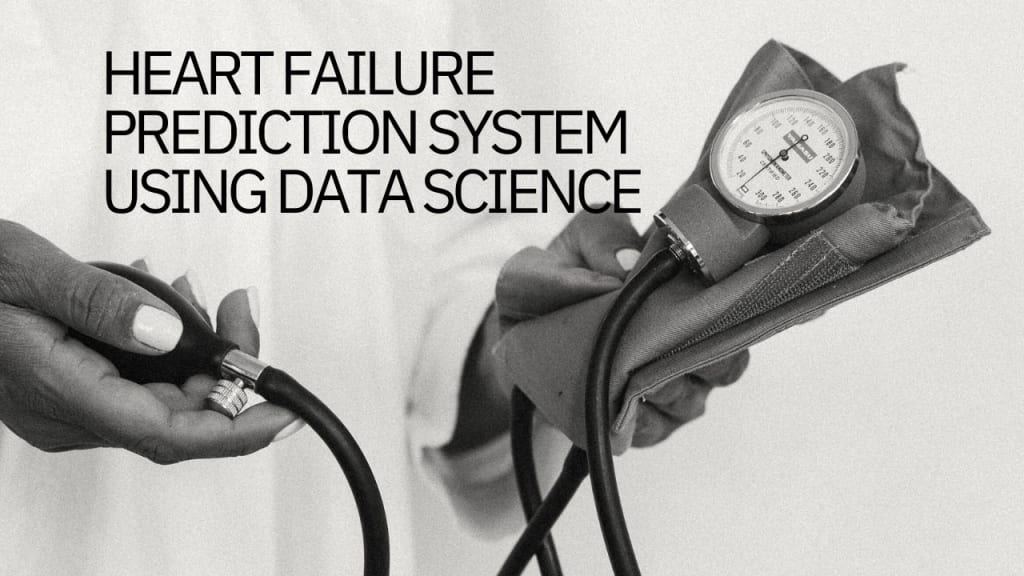Heart Failure Prediction System using Data Science
With the increasing availability of healthcare data, it is now possible to develop sophisticated machine learning algorithms that can help predict and diagnose various health conditions.

Data science is a rapidly growing field, and one of the most exciting applications of this field is in healthcare. With the increasing availability of healthcare data, it is now possible to develop sophisticated machine learning algorithms that can help predict and diagnose various health conditions. In this blog, we will discuss a data science project that focuses on predicting heart failure using machine learning algorithms.
Heart failure is a chronic condition that affects millions of people worldwide. It occurs when the heart is unable to pump blood efficiently, leading to a variety of symptoms such as fatigue, shortness of breath, and swelling in the legs and feet. Predicting heart failure can be challenging, but machine learning algorithms can help by analyzing patient data and identifying patterns that indicate a high risk of heart failure.
The heart failure prediction system we will discuss in this blog is based on machine learning algorithms that use patient data to predict the likelihood of heart failure. The system is designed to be used by healthcare professionals to identify patients who are at high risk of heart failure and provide them with appropriate treatment.
Data Collection
The first step in building a heart failure prediction system is to collect data. In this project, we collected data from the publicly available Heart Failure Prediction dataset on Kaggle. The dataset contains data on 299 patients with heart failure, including their age, sex, smoking status, blood pressure, serum creatinine, ejection fraction, and various other clinical and laboratory variables.
Data Preprocessing
Once we have collected the data, the next step is to preprocess it. Data preprocessing involves cleaning the data, dealing with missing values, and transforming the data into a format that can be used by machine learning algorithms.
In this project, we performed various preprocessing steps, including:
Removing duplicate records
Dealing with missing values by either removing the corresponding rows or imputing the missing values using mean, median, or mode.
Scaling the features to ensure that they have a similar range and are comparable.
Exploratory Data Analysis
Exploratory Data Analysis (EDA) is an essential step in any data science project. EDA involves analyzing the data to gain insights into its underlying structure and characteristics. In this project, we performed various EDA techniques to understand the dataset better.
Some of the EDA techniques we used in this project include:
Data visualization: We used various data visualization techniques such as histograms, box plots, and scatter plots to visualize the data and identify any patterns or trends.
Correlation analysis: We performed correlation analysis to identify any relationships between the features in the dataset. Correlation analysis helps identify which features are strongly correlated with heart failure and which features are not.
Feature selection: We performed feature selection to identify the most important features in the dataset. Feature selection helps identify which features are most relevant for predicting heart failure.
Model Building
The next step in building a heart failure prediction system is to develop a machine learning model. In this project, we built several machine learning models using different algorithms, including logistic regression, decision trees, random forests, and support vector machines.
The machine learning models we built in this project used the preprocessed dataset as input and outputted a prediction of whether a patient was likely to experience heart failure or not.
Model Evaluation
Once we have built the machine learning models, the next step is to evaluate their performance. Model evaluation involves testing the models on a separate test dataset and measuring their performance using various metrics such as accuracy, precision, recall, and F1 score.
In this project, we evaluated the performance of the machine learning models using various metrics, including:
Confusion matrix: A confusion matrix is a table that is used to evaluate the performance of a classification model. It shows the number of true positives, true negatives, false positives, and false negatives predicted by the model.
About the Creator
Divya Singh
My writing style is versatile, allowing me to write for a wide range of audiences. Whether it's crafting blog posts, social media content. I always strive to create content that is both informative and enjoyable to read.






Comments
There are no comments for this story
Be the first to respond and start the conversation.